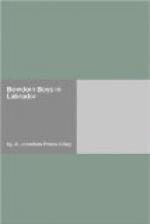Here, also, we laid in a supply of the only fruit that Labrador produces, called “bake apple.” It is a berry of a beautiful waxen color when ripe, otherwise looking much like a large raspberry, and having a most peculiar flavor, which we learned to like, and grew very fond of, when the berries were served, stewed with sugar. We had been deprived of fresh fruit so long that we should probably have learned to like anything, however odd its flavor, that had its general characteristics.
Here, too, we again fell in with our little Halifax trader, which gave us so hot a race to Halifax in the coming week, both vessels arriving at Halifax within an hour of each other, after starting at the same time from Red Bay and keeping within sight nearly all the time. At length the wind came to the south, and we started, laying our course west, along the Labrador shore, so as to get a windward position and be able to “fetch” Canso when the wind came around to the west, as it is certain to do at that season of the year, compelling us to “tack ship” and stand right out against the stormy Gulf of St. Lawrence. These southwesterly winds had been our dread, for they blow so strongly and in September make the Gulf so rough that getting to windward against them is impossible. Hence our satisfaction can be imagined as we sped along the Labrador coast that day, the wind becoming a trifle easterly, so as to allow us to “start our sheets” and at the same time steadily increase our offing, getting such a weatherly position for Canso that the moment the expected change of direction began we promptly “tacked ship” and at the worst had a leading wind across.
For three days we hobnobbed with the little “Minnie Mac” across the Gulf. The first thing we did in the morning was to hunt her up with the glasses from aloft, if not in sight from the deck, and the last thing in order at night were speculations as to where we should next see her. The difference in the build of the two vessels, the one being shoal and centerboard, the other deep and heavily laden, made the race a zigzag. When the wind favored a little and the sheets could be “eased” then the shoal model would push ahead, but when the wind came more nearly ahead, and we had to plunge squarely into a head sea, then the deeper draught and heavier lading told to advantage.
During this time we were not idle on board. The Grand River men were beginning to feel vigorous again, and their notes and data had to be worked up. The collections, too, though largely packed away securely for the rough voyage, yet gave plenty of occupation to those not otherwise employed, while the few really industriously inclined used their superfluous energy in seeing to it that the lazy were given no opportunity to enjoy their idleness.




